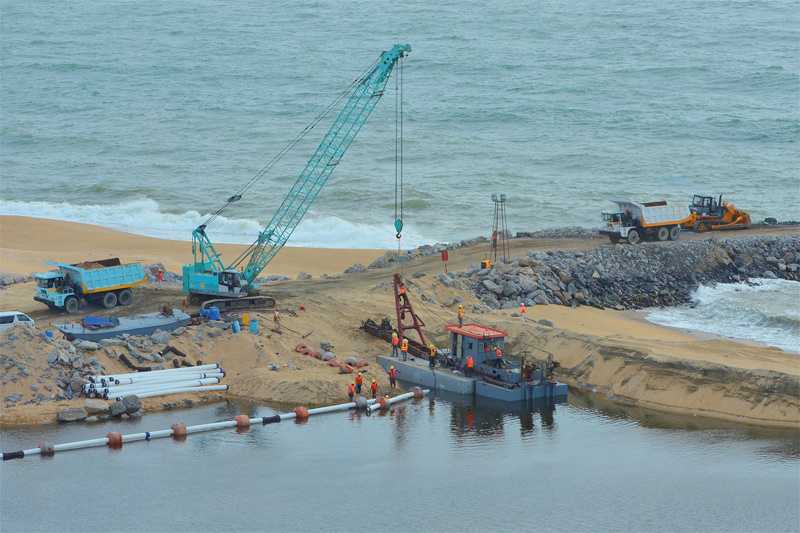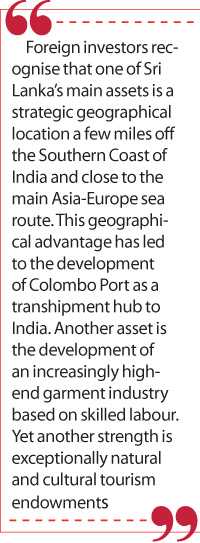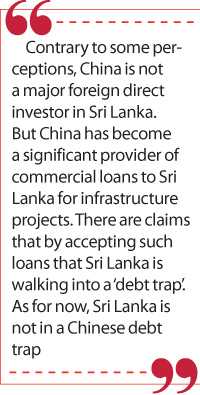Monday Jan 19, 2026
Monday Jan 19, 2026
Friday, 25 December 2020 00:00 - - {{hitsCtrl.values.hits}}

The Colombo Port City could be a game-changer for the modern service sector-led development – Pic by Shehan Gunasekara
Following are excerpts of an interview with Dr. Ganeshan Wignaraja by Pathfinder Foundation Programs Executive Utthara Wanigasekara
|
Dr. Ganeshan Wignaraja
|
Special Economic Zones are virtual economic tools used the world over to leverage and boost economies for the betterment of countries and to secure a significant spot in the trading map internationally.
Modern Special Economic Zones bear a noteworthy aspect in modern history since it had been established nearly 70 years ago in Ireland, first being the Shannon Airport exclusive zone set up in 1950. Latterly special zones aimed at achieving economic emancipation spread throughout Latin America and East Asia. Chinese leader Den Xiaoping moved to launch the first-ever exclusive trading zone in China in 1979 during the Chinese civil war, a first step towards the extension of the ancient trade route linking China and the Roman Empire. Silk became the main trading item from China in exchange for Silver and Gold from European destinations.
The objective of Special Economic Zones is to encourage rapid economic growth leveraging tax benefits and relaxation of exchange control regulations in a bid to attract foreign direct investments (FDI). It also had an added advantage of transferring technological advancements to the host country. New trade and economic laws are imperative to offer concessions as duty-free conclaves for the benefit of the investors and the creation of different administrative models which are in contrast with the laws of the mainland. These zones deemed to function as foreign entities for trade tariffs which in turn would benefit the investors to produce goods at a lower price. Jayanthakumaran, K. & Weiss, J. (1997). Export processing zones in Sri Lanka: a cost-benefit appraisal. Journal of International Development, 9 (5), 727-737 states.
As a part of its wider policy of export diversification and expansion, in 1978 the
Government of Sri Lanka established its first EPZ at Katunayake under the authority of the Greater Colombo Economic Commission (GCEC). Besides, two further zones became operational: one at Biyagama in 1986 and the other at Koggala in 1991. Foreign investment was expected to play a key role in the zones and, in addition to the normal practice of access to duty-free imports of inputs required for production, significant tax concessions were offered to attract investors. A 100% tax exemption for up to 10 years was offered to all manufacturers who entered into agreements with GCEC.
Initially, the minimum eligible tax holiday period was determined by considering the level of employment that the enterprise created, with a minimum of five years for those creating more than 500 jobs. This tax holiday applies to corporate and personal income, royalties and dividends. The minimum period can be extended for up to 10 years depending on factors such as net foreign exchange earned on export sales, the extent of employment created, the extent of new technology brought and the magnitude of capital investment. At the end of the tax holiday period, a further concessionary tax period follows up to a maximum of 15 years. During this period, a tax based on the turnover of only 2-5% comes into effect in place of income and corporate tax. The exact tax rate will be determined on a case-by-case basis. Also, the following incentives were announced: • no limits on the equity holdings of foreign investors; • free transfer of shares within or outside Sri Lanka; • no tax or exchange control on such transfers; • dividends of non-resident shareholders exempt from any taxes and remittances of such dividends exempt from exchange control; • no import duty on machinery, equipment, construction materials and raw materials; • all imports and exports to and from the zone to be exempt from normal import control and exchange control procedures; • transfer of capital and proceeds of liquidation exempt from exchange control.
To attract foreign investors, the GCEC, in its advertisements, publicised not only the comparatively high tax concessions but also the comparatively low public utility and labour costs. A free water facility and relatively low electricity cost (2.2 US cents per kilowatt-hour) were offered initially. Also, relatively low average labour costs ($ 0.13 per hour for unskilled, $ 0.16 per hour for semiskilled and $ 0.19 per hour for skilled labour) were advertised. The above costs were lower than in other Asian countries such as India, Malaysia, the Philippines, South Korea and Taiwan (Bastian, 1980). Also, EPZ enterprises received developed factory sites with all infrastructure requirements at a nominal charge.
As the Colombo Port City nears completion of its construction work, a comprehensive study with insights into economic prospects and expert comments on the establishment of the Special Economic Zone in this strategic geographical location would benefit the prospective investors to weigh the pros and cons in the present political and economic climate. The underscoring reality is that such a study is more appropriate with the COVID-19 pandemic, rampant and forced countries to review their economic policies and priorities.
Dr. Ganeshan Wignaraja who holds a Doctorate in Economics from the Oxford University, a senior Visiting fellow of the Pathfinder Foundation, Member of the Monetary Policy Consultative Committee of the Central Bank of Sri Lanka and Senior Research Associate at Overseas Development Institute London examines the trends of the FDI outlook for emerging markets such as Sri Lanka.
He expresses the opinion that The Colombo Port City (CPC) SEZ can be a game-changer for modern services-led development in Sri Lanka. Besides, he states that some policy insights from successful SEZs are available from recent cross-country studies which can be adapted to suit the Sri Lankan context.
Dr. Wignaraja gave an insight into the prospects of the Colombo Port City in the international political context in this interview:
Q: What is the FDI outlook for emerging markets in a COVID-affected world economy?
Globally foreign direct investment flows (FDI) in 2020 expected to be hard hit by the pandemic and 2020 levels are likely to be at least 40% below those seen in 2019. The consensus forecast is that global FDI flows could partially recover in 2021-2022 amidst high global uncertainties on the length of the health crisis, on the effectiveness of policies mitigating the pandemic’s economic effects and on foreign investor perceptions of emerging markets.
In general, it is also likely that a recovery in global FDI flows may be more largely, towards safer markets in advanced economies and less towards riskier emerging markets particularly those with high levels of external debt. The silver lining is that Asia, projected to recover faster than other emerging markets, is likely to get the lion’s share of global FDI inflows to emerging markets. Much of Asian FDI inflows could be destined, towards much larger and more vibrant economies such as India, Viet Nam, Indonesia and Thailand.
Q: How is Sri Lanka positioned in the eyes of foreign investors?
FDI inflows averaged less than $ 1 billion annually between 2010 and 2019. In 2020, FDI flows were significantly below par due to the pandemic. FDI to Sri Lanka is below par for a middle-income economy and given expectations of a large peace dividend since the end of the 30-year conflict. Sri Lanka’s underperformance in FDI record despite vast FDI potential is sobering.
Foreign investors recognise that one of Sri Lanka’s main assets is a strategic geographical location a few miles off the Southern Coast of India and close to the main Asia-Europe sea route. This geographical advantage has led to the development of Colombo Port as a transhipment hub to India. Another asset is the development of an increasingly high-end garment industry based on skilled labour. Yet another strength is exceptionally natural and cultural tourism endowments.
On the liabilities side, however, Sri Lanka’s small internal market of only 22 million people with a relatively small middle class of consumers is seen as being an inherent disadvantage for manufacturing FDI compared to South Asian neighbours like India or Bangladesh. The business environment in Sri Lanka is also seen, as being mired in red tape and not being very business-friendly to foreign investors. Finally, rating agencies and international banks argue that Sri Lanka is at risk of sovereign debt distress which is a worrisome new label for Sri Lanka. 
Q: Has Belt and Road (BRI) investment engulfed Sri Lanka into a ‘Chinese Debt Trap’?
Contrary to some perceptions, China is not a major foreign direct investor in Sri Lanka. But China has become a significant provider of commercial loans to Sri Lanka for infrastructure projects. There are claims that by accepting such loans that Sri Lanka is walking into a ‘debt trap’. As for now, Sri Lanka is not in a Chinese debt trap. The latest available data suggest that Sri Lanka’s external public debt owed to China amounted to $ 5 billion in 2018 (equivalent to about 6% of its GDP). Sri Lanka owes more of its external public debt to financial markets, multilateral and bilateral lenders than to China. However, Sri Lanka’s generally high debt to GDP levels over the last decade reflects factors such as weaker economic performance and the notable currency depreciation. To reduce, the risk of the Chinese debt trap in the future, the country needs to seek to negotiate debt standstills, improve its borrowing and debt management systems, and build its external reserve buffers.
Q: How do you evaluate the benefits of Chinese infrastructure investment into Sri Lanka?
The cumulative value of Chinese infrastructure investment to Sri Lanka amounted to about $ 12.1 billion between 2006 and 2019. Some projects predate the BRI launched in 2013. Specific projects have contributed positively to Sri Lanka’s economy. Some have brought more benefits than others, such as the Colombo International Container Terminal (CICT), which has allowed the Colombo port to become South Asia’s transshipment hub. The Colombo Port City (CPC) could be a game-changer for the modern service sector-led development. However, imports from China for projects in Sri Lanka have widened the trade deficit between the two countries. Besides, there have been only limited economic spillovers for Sri Lanka, including knowledge transfer in the local labour force or manufacturing foreign investment from China.
Q: What insights can be drawn from Dubai’s experience of attracting foreign investment and SEZs?
The city of Dubai is, regarded as a developmental success story in the Middle East and globally. It powered the economic rise of the United Arab Emirates (UAE) to be a high-income economy with a per capita income over $, 40,000. Within three decades or so, Dubai has transformed itself into an enviable international hub for foreign investment, business, high-end culture and tourism. It has leveraged a strategic location between Asia and Europe asset and developed some 30 SEZs. Political stability, excellent branding as an investment destination, a competitive tax regime and world-class infrastructure in its SEZs, an open labour market for attracting skilled workers and professionals, and consistent business-friendly economic policies help explain the success of Dubai. 
Q: Can the Colombo Port City SEZ turn Sri Lanka into the new Dubai?
The Colombo Port City (CPC) SEZ can be a game-changer for modern services development in Sri Lanka. Sri Lanka has the twin advantages of leveraging a strategic geographical location and drawing on the experience of SEZs in Dubai and others of what works. It will take time to show results, particularly in the uncertain post-COVID global era. By putting in place a competitive SEZ framework and conducive national policies will markedly improve the chances for the Port City to succeed overtime against the backdrop of an uncertain post-COVID-19 economic era. This means that Sri Lanka should rapidly implement a CPC SEZ framework that has several core elements (1) a transparent and competitive tax regime, (2) an open international labour market, (3) a clear arbitration framework for parties to solve commercial disputes, and (4) modern and cost-competitive infrastructure. It also means that like the UAE, Sri Lanka’s national policies emphasise a market-oriented economy, a neutral foreign policy, a world-class education system and moves towards political and social stability.
Q: Many countries in the world have set up Special Economic Zones (SEZs) to ensure the rapid growth of the economy, what are the global experiences that Sri Lanka could derive from such phenomena?
Some policy insights from successful SEZs are available from recent cross-country studies which can be adapted to suit the Sri Lankan context. First, SEZs are a vital development policy tool not only for promoting inward investment but also for facilitating industrial clustering. Notable, spillovers, can be gained from sharing resources and costs by locating related industrial activities in given geographical locations. Second, regulatory and governance frameworks should be adaptable. The role of government is setting regulatory frameworks for SEZs. But the development and ownership of SEZ be public, private or a public-private partnership (PPP). Third, competitive fiscal incentives are of importance to initial investments in industrial ventures along with institutional factors (like an efficient SEZ governing authority, a supporting legal framework and a flexible labour market). But there is an on-going debate on the economic costs and benefits of some fiscal incentives like long tax holidays.